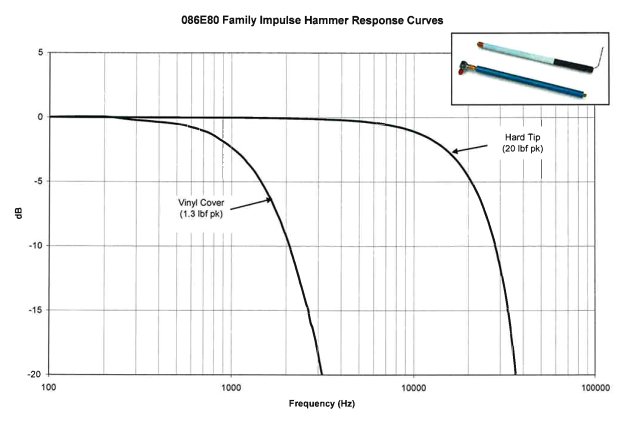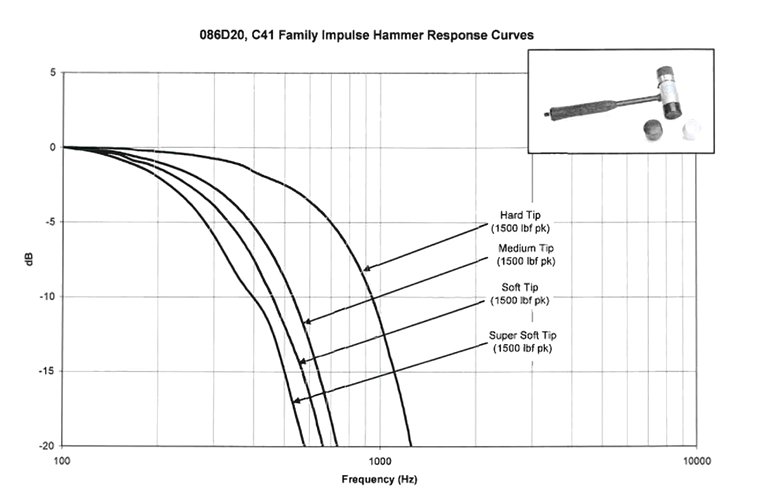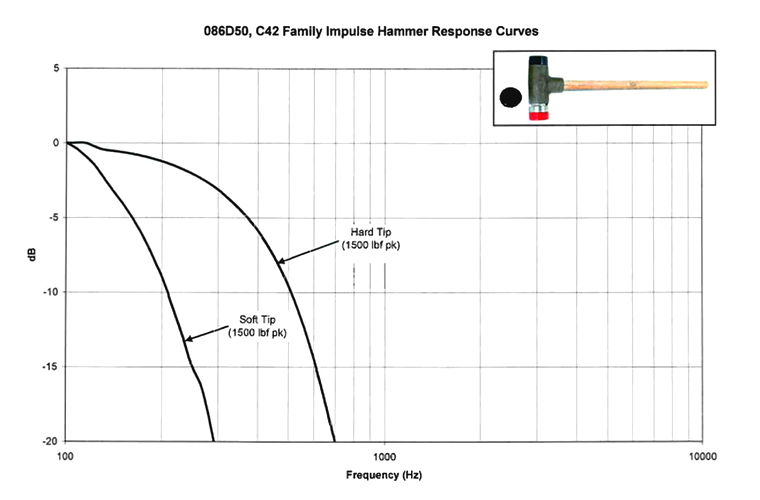Main Menu
- Home
- Product Finder
- Calibration Systems
- Calibration Services
- Digital Sensing
- Industrial Vibration Calibration
- Modal and Vibration Testing
- Non-Destructive Testing
- Sound & Vibration Rental Program
- Learn
- About Us
- Contact Us
The hammer, size, length, material, and velocity at impact determine the amplitude and frequency content (wave shape) of the force impulse. The impact cap material generally determines the energy content. The force spectrums of an impact on stiff steel mass for hammers with their available tips are shown below. Selecting the correct impact tip to excite the right frequency range is critical to optimizing the measured response..
Modal Space Article: Should I always use a hard tip for impact testing so the input spectrum is flat over all frequencies?
Modal Space Article: Is there any effect in impact testing when hitting harder or softer with the different tips?




It is a matter of getting adequate energy into the frequency range of interest. Larger more massive items will have lower resonant frequencies and the mass also adds more damping to the structure requiring more force to excite the structure enough to observe its responses. With a heavier hammer we are not able to excite high frequencies very well. The hammer will be in contact with the structure longer limiting the high frequency energy it imparts. We can modify this a little bit by the choice of hammer tip. A harder hammer tip will excite to a higher frequency and a softer tip will excite to a lower frequency.
To get the force, a heavier hammer is the easiest way (F=ma). For example, the 086D20 is a 2.4 lb effective mass and the 086D50 a 12 lb effective mass.
The instrumented Modal Punch (Model 088A) can be used to perform structural testing on automotive axles, gearbox shafts, machine tools and other points inaccessible by standard impact hammers. The Modal Punch has the ability to be used with your own non-instrumented hammer.
Yes, the super soft plastic gray tip made of polyurethane (Model 084A30) is discontinued by PCB and no longer supplied with the 086D50 hammer. However, the super soft plastic gray tip (Model 084A30) is still available within our rental stock upon request.
The Frankenhammer (Model 087B50) is a mix between the Model 086D20 hammer handle size combined with the mass of a Model 086D50 hammer impacting mass; hence the Frankenstein construction of a Modal Hammer. The Model 087B50 electrical connection is a 10-32. The Frankenhammer has the 12.1 lb effective hammer mass on a shorter handle used for getting into hard to reach area that require a higher impacting force.
Double impacts are when the hammer strikes the test object twice upon being impacted and occur due to a sloppy hammer swing or many times due to the responsive nature of many structures and they should be avoided wherever possible.
Shakers and stingers are the two main methods of excitation used and both have their pros and cons in a number of situations. In some cases one method is clearly superior to the other, but overall they should be viewed as two tools of the modal tool box to be used together.
Hammers are quick deployment with minimal set up time, cost effective and have the benefit of not physically being attached to the structure like a shaker (influencing the boundary conditions). We have a number of different hammers to choose from and with each hammer different tips or extended hammer masses to further hone in the frequency range excited with the hammer. Being highly portable it allows us to impact at multiple locations on the structure, even hard to reach, as well to build a complete set of data all while using a typical ICP input channel. It is also much easier to input higher levels of force into large structures (foundations, machine tools) with the use of the modal sledge hammers vs a shaker. When using a shaker to test more massive, and heavily damped structures either many shakers or a very large, high force shaker would be needed.
However, while set up is quick, executing a hammer test can be more time consuming because of the multiple impact locations. One will need to make multiple impacts at each location to average the data. This is because of the inconsistency of the hammer strike not being the same force, same location, or same angle at each impact. It is a human swinging the hammer in the end, and we are not able to make identical strikes repeatedly. A hammer will also not be well suited for non-linear objects either because of the inconsistencies of the human swinging the hammer. A controlled, consistent force input is needed to test non-linearities.
Shakers, on the other hand, take longer to set up and are physically connected to the structure slightly altering the boundary conditions of the test structure. They need some amount of dedicated space, maybe some special method to hold the shaker where needed, and the alignment of the stinger is critical to the exciting the test part. Even the stinger length and diameter (stiffness) play a role in the test since this is what connects the shaker to the test part. Too big and/or short a stinger can cause the structure local stiffness to be altered significantly. To skinny and/or long can cause the stinger to buckle and create force drop outs. Shakers may not be well suited for very small items either.
Once set up is complete the shaker is an excellent method to make controlled, repeatable measurements and, with multiple shakers, fully energize a test structure to observe the responses all at one time. The test time can be quite short as well because of this. We also have the benefit of a number of different drive signals that can be used to excite the structure, ranging from a sine sweep, to pure random, to burst random. With the ability control force levels at the same input point shakers are best suited for working with non-linear structures, or checking linearity of a structure.
Shakers and hammers do not have to be used exclusively either. In fact, hammers are very useful to help choose the proper location to connect shakers to a structure. A quick, smaller pretest can be performed with a hammer to help learn in rough terms about the structures modes to guide the user in where to attach the shaker. If a shaker is attached at the node of a mode of interest that mode would not be excited and excluded from the survey accidentally. Since the hammer is easy to rove around to multiple locations it is a quick way to understand where the mode nodes may be.
Due to the unique nature of impact measurements, it is advised by manufacturers that users should calibrate the hammers in the tip/extender configuration that they will be used. For this reason, it is common to calibrate impact hammers a number of times for different tip/extender combinations.
The 084A14 plastic handle offers broad frequency range impact characteristics. Choose the plastic handle for general purpose testing to higher frequencies, but be aware that it requires a delicate touch, and care should be taken to avoid damaging the handle and to avoid double impacts.
To excite lower frequencies, mount the 084A13 extender mass to the back of the hammer per the outline drawing and use the 084A17 aluminum handle. It is a matter of preference, but some feel the 084A17 aluminum handle provides better control.